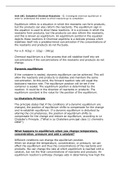Essay
Unit 18C - Industrial Chemical Reactions - distinction received
- Course
- Institution
Unit 18C - Industrial Chemical Reactions - distinction received cheap and copy and paste it into your assignment for distinction, and when you need to hand in assignments quickly.
[Show more]



